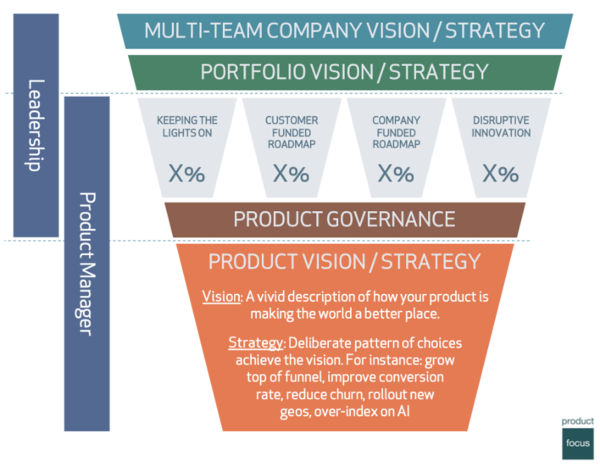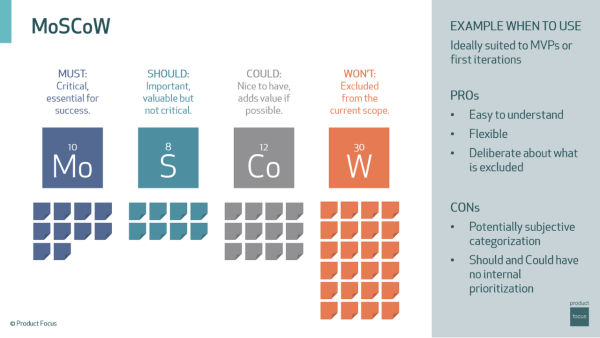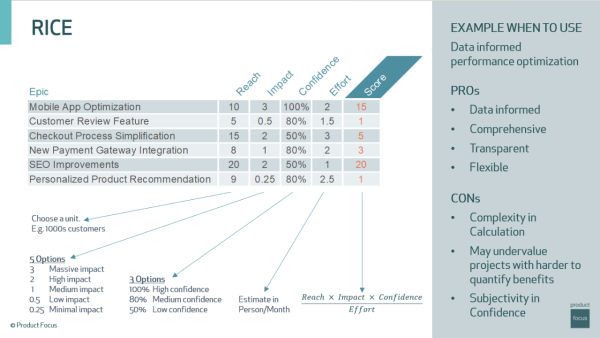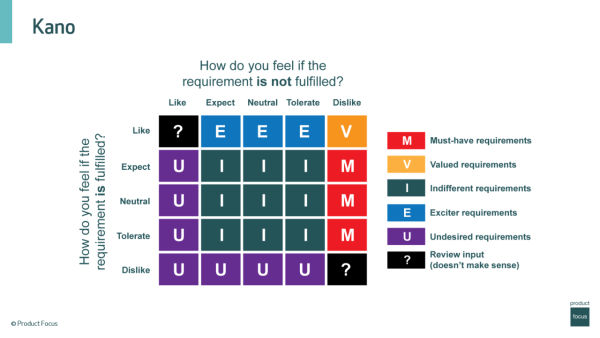
Prioritization. It’s easy, right?
You might assume that adding a new feature simply means finding enough roadmap space and selecting the right feature.
Unfortunately, the reality is far from simple…
Prioritization can be a real struggle for product managers. This blog equips you with battle-tested frameworks and techniques for making tough prioritization decisions. Learn how to weigh user needs, business goals, and technical feasibility to build the right products at the right time.
The Importance of Prioritization in Product Management
Consider this example: two TV remote controls released around the same time.
Despite their similar purpose, they couldn’t be more different. It’s clear that the team behind the left remote were very accommodating to feature requests, opting to include buttons and features to cover every use case. But, when everything is deemed equally important, nothing truly is, resulting in products without a clear focus. Even the most skilled user-experience designers will find it a challenge to create an intuitive customer experience for a ‘every-use-case-is-equally-important product’.
So, how do we achieve a more intuitive user experience? How might we deliver something with the elegance that Apple might design? Ruthless prioritization could be the answer. Choosing not to include features that distract from the main product purpose and primary user experience.
Think of it like sculpting a statue: you chip rock away until it resembles your clear vision. You’ve probably heard the phrase “focus is about saying no”, famously attributed to the late Steve Jobs. It’s worth revisiting the context of his remark, which you can find in a YouTube video from the Worldwide Developers Conference 1997. This was about thirteen years before the remote controls we mentioned earlier were released.
Prioritization isn’t about sequencing every possible feature for delivery; it’s about acknowledging that some features should never be road-mapped or delivered – and that’s okay. We can’t endlessly accumulate ideas in our backlogs – it diffuses focus and complicates your product management job. Yet, discarding them might feel wasteful or uncaring for stakeholders that suggest them. Thus, we must establish strategic filters upfront, even before considering specific roadmap candidates.
Filters start with strategy and governance

Vision, Strategy, and Governance can act as filters to help guide prioritization decisions at every level from company through to portfolio and product level.
Within large organizations, different teams align under the main company vision and strategy, while each team or portfolio may also have its own. Product Governance then guides resource allocation across these chosen areas. One such allocation might be for “keeping the lights on”. This might include tech debt, essential updates, or preventive maintenance; you may have customer-funded roadmap items for B2B scenarios. Contrastingly, in B2C, this approach might not apply.
Then, there’s the company-funded roadmap items, aligned with the company’s direction and future vision. As an example, there could be an allocation for disruptive innovation.
Why is this approach useful? Well, once you’ve determined the resource distribution for each ‘bucket’ allocation, it simplifies decision-making amid the constant influx of ideas from various sources like sales, customer service, and technical leaders. With each aspect assigned its own roadmap ‘lane’, such as dedicating 20% to tech debt and preventive maintenance, decisions become clearer. It eliminates the confusion of trying to prioritize tasks like API refactoring against other tech items like SEO improvements, or KPI initiatives. Setting upfront resource allocations ensures a balanced investment and streamlines decision-making.
Without this structured approach, creating a high-level roadmap is like trying to fill a small bucket with a fire hose. An exercise in frustration.
Next, your product vision and strategy act as a third filter. A robust product vision is essential to determine which roadmap candidates align with your user’s most important needs.

In a single-product start-up, the company vision and strategy can often be the same as the product vision and strategy.
It’s crucial for companies to envision how a product delivers customer delight and contributes to company success and strategy. In a start-up, this link is often incredibly direct – where the company vision and strategy are often the same as the product vision and strategy.
A potent vision is one that’s vivid and tangible, such as Microsoft’s iconic 1980s aspiration: “A computer on every desk and in every home running Microsoft software.” This clear, focused vision not only sets a direction but also provides a concrete target to aim for, aiding in decision-making and guiding product efforts across the company.
Understanding Prioritization Models: MoSCoW
Now equipped with a solid product vision and aligned investment buckets, the next crucial step is prioritization within each bucket. Let’s delve into a few prioritization models, starting with MoSCoW. This model, conceived by product manager Day Clegg in the 1990s during his tenure at Oracle, categorizes requirements into four distinct categories: Must, Should, Could, and Won’t have. It’s lauded for its simplicity and clarity in delineating what’s essential for an initial release (Must-haves) versus what could be deferred to subsequent iterations. The MoSCoW model is particularly effective in defining a Minimum Viable Product (MVP), as it explicitly outlines what won’t be included, setting clear boundaries and expectations for stakeholders.

Moscow prioritization is straightforward to understand, but its subjective nature can be a challenge.
However, while MoSCoW is straightforward and easy to understand, its subjective nature can pose challenges. Without explicit criteria or prioritization within the Should and Could categories, teams may struggle to make informed decisions, leading to potential scope creep or misaligned priorities.
Understanding Prioritization Models: RICE
Another popular prioritization framework is RICE, pioneered by Intercom. RICE stands for Reach, Impact, Confidence, and Effort, and it provides a structured approach to prioritizing tasks based on their potential impact and feasibility. Reach refers to the number of users or customers affected by the task. While Impact quantifies the potential effect on key metrics or objectives. Confidence reflects the team’s certainty in the estimates, typically rated on a scale of 50, 80, or 100 percent. Finally, Effort measures the resources required to complete the task, usually expressed in person-months.

Rice (reach, impact, confidence, effort) prioritization is more data-driven and was pioneered by Intercom.
RICE offers a more data-driven approach to prioritization, leveraging quantitative measures to inform decision-making. However, it can be more complex to implement, especially for projects with ambiguous benefits or lower confidence levels. Despite its challenges, RICE provides a comprehensive and transparent framework for strategic prioritization. Aligning closely with organizational objectives and guiding resource allocation effectively.
Subjectivity remains a factor in prioritization. Reach, in models like RICE, isn’t purely formulaic; its influenced by calculated estimates.
Customer-Centric Prioritization: Insights from Noriaki Kano’s Model
Moving beyond RICE, we encounter a model proposed by Professor Noriaki Kano of Tokyo University. This model emphasizes consumer insight, categorizing requirements based on two questions: How would you feel if the requirement is fulfilled? And how would you feel if it is not fulfilled?
Consider a hotel experience. Unexpected perks like a free minibar can boost ratings, while glaring omissions like missing door locks are a must-have. Other features fall into valued or indifferent categories, with complex tech controls often alienating guests. There is a sequence that can be followed: prioritize must-haves, then valued and desired features, considering audience preferences – taking not that what’s valued by one segment may be undesired by another.
Operationalizing this model involves placing each requirement on a matrix based on customer sentiment. Yet, priorities can shift; what’s exciting today may become expected tomorrow. Moreover, excessive addition of “exciters” can make the product and features unwieldy.

The Kano model for prioritization is effective when you have rich qualitative customer insights or when trying to align expectations in new segments and markets.
Lastly, it’s crucial to recognize that must-haves cannot be substituted with mere exciters. Attempting such swaps risks compromising essential functionality, potentially deterring users, regardless of additional perks. So, while a hotel might offer a free minibar and a large pool, omitting an aircon (especially in a hot country) will likely deter most guests, highlighting the importance of prioritizing essential features over exciters.
This model is particularly effective when you have rich qualitative customer insights or when expanding into new markets to align expectations. It’s inherently customer-centric and can serve as an initial stage to gauge value and inform other models. Its pros lie in its user insight-driven approach, but it may lack granularity within each category and could potentially neglect must-have requirements if implemented incorrectly.
Exploring Additional Approaches
Another useful model, suitable for annual planning, is the value-versus-complexity approach. While it doesn’t dictate prioritization, it aids in visualizing options, identifying quick wins, and highlighting major projects. It underscores the importance of aligning value with strategic objectives rather than subjective assessments.
Lastly, the weighted scorecard model is highly effective for driving strategic alignment and reducing subjectivity. By rating each strategic pillar and scoring initiatives based on their alignment with those pillars, it provides a comprehensive view of value alignment. However, setting it up can be more complex, and it still involves some degree of subjectivity in rating.
Ultimately, while these models offer valuable frameworks for prioritization, they’re only as effective as the data and insights used to inform them. The “garbage in, garbage out” principle underscores the importance of accurate inputs. To mitigate this, adopting a dual-track agile approach, allocating resources to both discovery and delivery, can help address uncertainties and minimize risks, as outlined by Marty Cagan in his book “Inspired.”
In summary, each model has its strengths and weaknesses. Their suitability depends on factors like available insights, strategic objectives, and organizational context.
Key Factors in Strategic Prioritization: Value, Feasibility, Usability, and Viability
When it comes to strategic prioritization in product management, there are a few key factors to consider: value, feasibility, usability, and viability. Ethics can also play a role, but let’s stick with the basics for now.
Value is all about whether your idea actually matters to users. You can test this with techniques like conversion rate experiments or by chatting with customers using approaches like the “mom test” from Rob Fitzpatrick.
Feasibility is where your engineering team jumps in, creating prototypes to see if your idea is doable. Sometimes these prototypes end up in the trash, but hey, it’s all part of the process!
Usability, you can check this with prototypes and with tools like Figma or Sketch to see how users interact with your visual designs.
Viability is when you crunch the numbers to figure out if your idea is financially sound or sensible to proceed with.
Once you’ve got all that sorted, you can feed it into a weighted scorecard model to make sure everything lines up. This way, you’ll feel more confident about your project’s success. Plus, you are less likely to hit any nasty surprises down the road.
The Secret to Strategic Prioritization in Product Management
Be on the same page with your leadership. Have a strong vision. Establish those investment buckets e.g., tech debt, strategic roadmap, sales requests, and always keep an eye on value, feasibility, usability, and viability.
It’s essential to set clear agreements upfront to keep each product or feature category in its own lane. Once that’s done, you should choose one or more models to figure out your priorities. Finally, consider the dual track Agile approach if appropriate to your product. This method can help avoid the headache of prioritizing based on a double-guess.
So, there you have it – the secret sauce to prioritizing product features – like a pro!
This blog illustrates some important lessons from the webinar delivered by Cyril Le Roux, a Product Focus Senior Consultant. He has over 20 years of product management experience. Mainly across Telecoms, eCommerce, Marketplaces (in real estate, trades, and print on demand), and FinTech.
Don’t forget to register for free, to receive access to the Product Focus Toolbox. Get access to an online curated library of world class resources for product managers: whitepapers, infographics, journals, and more…



Join the conversation - 2 replies
Pertinent and timely to remind me of these methods.
We’re glad you found this blog helpful!